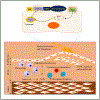Lysosome Function in Cardiovascular Diseases
- PMID: 34019755
- PMCID: PMC8743031
- DOI: 10.33594/000000373
Lysosome Function in Cardiovascular Diseases
Abstract
The lysosome is a single ubiquitous membrane-enclosed intracellular organelle with an acidic pH present in all eukaryotic cells, which contains large numbers of hydrolytic enzymes with their maximal enzymatic activity at a low pH (pH ≤ 5) such as proteases, nucleases, and phosphatases that are able to degrade extracellular and intracellular components. It is well known that lysosomes act as a center for degradation and recycling of large numbers of macromolecules delivered by endocytosis, phagocytosis, and autophagy. Lysosomes are recognized as key organelles for cellular clearance and are involved in many cellular processes and maintain cellular homeostasis. Recently, it has been shown that lysosome function and its related pathways are of particular importance in vascular regulation and related diseases. In this review, we highlighted studies that have improved our understanding of the connection between lysosome function and vascular physiological and pathophysiological activities in arterial smooth muscle cells (SMCs) and endothelial cells (ECs). Sphingolipids-metabolizingenzymes in lysosomes play critical roles in intracellular signaling events that influence cellular behavior and function in SMCs and ECs. The focus of this review will be to define the mechanism by which the lysosome contributes to cardiovascular regulation and diseases. It is believed that exploring the role of lysosomal function and its sphingolipid metabolism in the initiation and progression of vascular disease and regulation may provide novel insights into the understanding of vascular pathobiology and helps develop more effective therapeutic strategies for vascular diseases.
Keywords: Lysosome; Smooth Muscle Cells; Exosomes; Sphingolipids; Vascular Calcification.
© Copyright by the Author(s). Published by Cell Physiol Biochem Press.
Conflict of interest statement
The authors have no conflicts of interests to disclose.
Figures



References
-
- Christensen KA, Myers JT, Swanson JA: pH-dependent regulation of lysosomal calcium in macrophages. J Cell Sci 2002;115:599–607. - PubMed
-
- Churchill GC, Okada Y, Thomas JM, Genazzani AA, Patel S, Galione A: NAADP mobilizes Ca(2+) from reserve granules, lysosome-related organelles, in sea urchin eggs. Cell 2002;111:703–708. - PubMed
-
- Lawrence RE, Zoncu R: The lysosome as a cellular centre for signalling, metabolism and quality control. Nat Cell Biol 2019;21:133–142. - PubMed
-
- Jha KN, Kameshwari DB, Shivaji S: Role of signaling pathways in regulating the capacitation of mammalian spermatozoa. Cell Mol Biol (Noisy-le-grand) 2003;49:329–340. - PubMed
Publication types
MeSH terms
Substances
Grants and funding
LinkOut - more resources
Full Text Sources
Other Literature Sources

